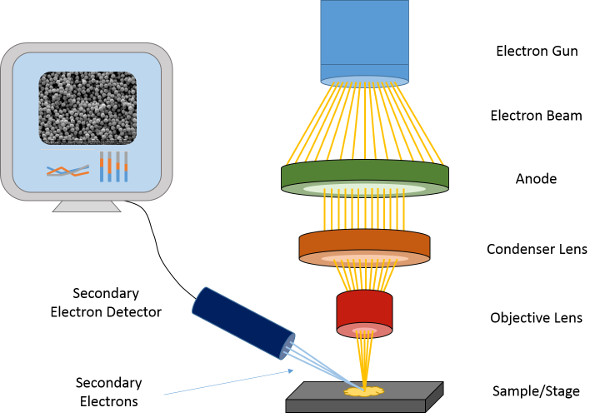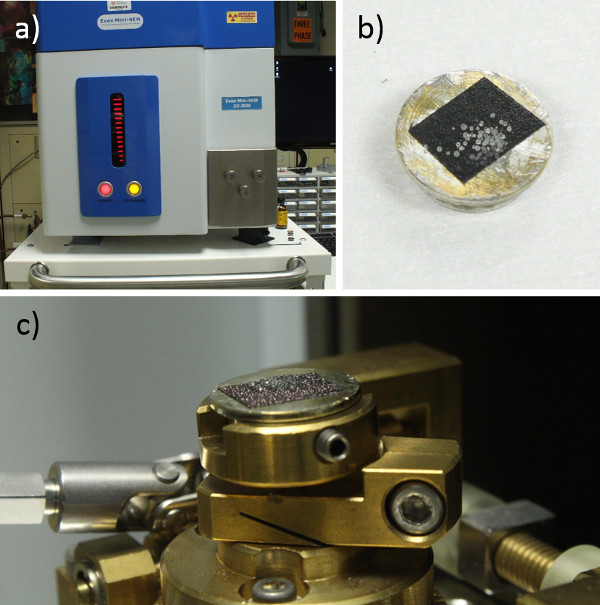스캐닝 전자 현미경 검사법 (SEM)
Overview
출처: 앤드류 J. 스텍클 박사 연구소 — 신시내티 대학교
스캐닝 전자 현미경 또는 SEM은 전자를 사용하여 이미지를 형성하는 강력한 현미경입니다. 그것은 전통적인 현미경을 사용하여 달성될 수 없는 배율에 전도성 견본의 화상 진찰을 허용합니다. 현대 광 현미경은 ~ 1,000X의 배율을 달성할 수 있으며, 일반적인 SEM은 30,000배 이상의 배율에 도달할 수 있습니다. SEM은 이미지를 만들기 위해 빛을 사용하지 않으므로 이미지가 형성된 결과 사진은 흑백입니다.
전도성 샘플은 SEM의 샘플 단계에 로드됩니다. 샘플 챔버가 진공 상태에 도달하면 사용자는 시스템의 전자 총을 적절한 위치에 정렬합니다. 전자 건은 렌즈와 조리개 조합을 통해 이동하고 결국 샘플을 명중 고에너지 전자의 빔을 발사합니다. 전자 총이 시료의 정확한 위치에서 전자를 계속 쏘면 이차 전자가 시료에서 튀어 나옵니다. 이러한 이차 전자는 검출기에 의해 확인된다. 이차 전자에서 발견된 신호는 증폭되어 모니터로 전송되어 3D 이미지를 생성합니다. 이 비디오는 SEM 샘플 준비, 작동 및 이미징 기능을 보여줍니다.
Principles
전자는 음극처럼 작용하는 전자 총에 의해 가열하여 생성됩니다. 이 전자는 강한 전기장으로 인해 샘플과 동일한 방향으로 양극쪽으로 추진됩니다. 전자의 빔이 응축된 후, 사용자가 시료의 고정 된 위치로 보정되는 객관적인 렌즈에 들어갑니다. (그림1)
전자가 전도성 시료를 공격하면 두 가지가 발생할 수 있습니다. 첫째, 시료에 부딪힌 1차 전자는 그 전자의 에너지 수준에 의존하는 깊이로 터널을 통과합니다. 그런 다음, 이차 및 백산전자는 샘플을 명중하고 그것에서 바깥쪽으로 반사합니다. 이러한 반사된 전자는 이차 전자(SE) 또는 백산(BS) 검출기에 의해 측정됩니다. 신호 처리가 수행되면 샘플 이미지가 화면에 형성됩니다. 1
SE 모드에서는 이차 전자가 낮은 에너지로 인해 검출기 전면에 긍정적인 편향을 가합니다. 신호 강도는 샘플의 각도에 따라 다양합니다. 따라서 SE 모드는 지형도가 높은 이미지를 제공합니다. 한편, BS 모드에서는 전자의 방향이 e-빔 방향과 거의 정반대이며 검출 강도는 시료의 원자 수에 비례한다. 따라서 지형도가 적지만 조성 이미지에 유용합니다. BS 모드는 또한 비 전도성 샘플에 도움이 되는 샘플에 대한 충전 효과에 의해 덜 영향을 받습니다. 1

그림 1. SEM의 회로도.
Procedure
1. 샘플 준비
- 샘플을 샘플 스텁에 놓습니다. 필요한 경우, 탄소 테이프는 샘플을 스텁에 접착제로 결합하는 데 사용될 수 있다.
- 샘플을 골드 스퍼터링 시스템에 넣습니다. 미니 골드 스퍼터를 사용하여 스퍼터 골드를 ~ 70 mTorr 압력에서 30 초 동안. 샘플의 형상에 따라 다른 금층 두께가 필요할 수 있다. 더 거친 또는 다공성 표면은 더 긴 스퍼터링 시간이 필요합니다.
- 골드 스퍼터링 시스템에서 스텁을 제거합니다.
2. 샘플 삽입 및 SEM 시작
- 챔버가 명목 압력에 도달 할 수 있도록 SEM 챔버를 배출합니다.
- SEM 샘플 구획을 열고 샘플 스테이지를 꺼냅니다.
- 샘플을 포함하는 샘플 스텁을 스테이지에 삽입합니다. 스텁을 제자리에 조이십시오.
- z-거리를 소프트웨어에 의해 제어할 수 없는 경우 샘플 스텁이 있는 샘플 스테이지에 더 나은 이미지를 얻기 위해 적절한 높이가 있는지 확인합니다.
- 샘플 스테이지를 샘플 챔버에 넣습니다. 샘플 구획을 닫습니다.
- 펌프를 켜고 시스템이 진공 상태에 도달할 수 있도록 합니다. 시스템이 완료되면 사용자에게 알립니다.
- SEM 소프트웨어를 엽니다. 1-30 kV에 이르는 원하는 작동 전압을 선택합니다. 작동 전압이 높을수록 이미지 대비가 향상되지만 샘플에 충전이 누적되면 해상도가 낮아질 수 있습니다.
3. SEM 이미지 캡처
- 키 아이콘을 클릭하여 SEM 소프트웨어에서 '자동 초점'을 시작합니다. 이렇게 하면 시작점으로 사용할 샘플의 집중된 이미지를 얻을 수 있습니다.
- 배율이 최소 줌 레벨인 50X로 설정되어 있는지 확인합니다.
- '빠른 스캔' 모드를 선택합니다.
- 거친 초점이 얻을 때까지 거친 모드에서 초점을 조정합니다.
- 관심 영역이 디스플레이에 표시되도록 외부 노브를 사용하여 수동으로 스테이지를 조정합니다.
- 원하는 피쳐가 관찰될 때까지 배율 수준을 늘립니다. 거친 초점 손잡이를 조정하여 이 배율에 이미지를 대략 집중시합니다. 그런 다음, 미세 초점 노브를 사용하여 초점을 개선하여 원하는 배율 수준에서 집중된 이미지를 얻습니다. 배율 수준이 증가할 때마다 이 단계가 반복됩니다.
- 원하는 배율에 도달하면 미세 초점 손잡이를 조정하여 선명도를 향상시킵니다.
- 이미지 선명도를 최적화하려면 배율을 최대 수준에 가깝게 늘린 다음 미세 초점 노브를 사용하여 이미지에 초점을 맞춥니다. 선명한 이미지를 얻을 수 없는 경우 x 및 y 방향으로 낙인을 조정합니다. 가장 선명한 이미지가 과장된 배율 수준에서 얻을 때까지 초점과 낙인을 계속 조정하십시오.
- 샘플의 품질 이미지에 도달한 후 원하는 배율 수준으로 돌아갑니다. 이미지는 '느린 사진' 또는 '빠른 사진' 모드에서 사진 버튼을 눌러 촬영할 수 있습니다. '느린 사진' 모드는 이미지의 품질과 고해상도를 제공합니다.
4. SEM 소프트웨어를 사용하여 측정하기
- '패널' 드롭다운 목록에서 'M. 도구'를 선택합니다.
- 길이, 면적 및 각도와 같은 다양한 측정은 SEM 소프트웨어에서 직접 측정할 수 있습니다. 이러한 측정 중 하나를 수행하려면 M. Tools 창에서 원하는 아이콘을 클릭합니다.
- SEM 이미지의 측정 사이트로 스크롤합니다. 측정은 이미지를 클릭하여 소프트웨어에서 분석할 참조 지점을 만들어 측정합니다. 측정된 데이터 포인트는 사용자가 원하는 경우 이미지에 직접 삽입할 수 있습니다.
- 그런 다음 이미지가 컴퓨터에 저장됩니다.
Results
그림 2a에서볼 수 있는 SEM은 측정을 하고 샘플 사진을 획득하는 데 사용되었습니다. 샘플은 염화나트륨(NaCl) 염분으로 구성되었다. 그것은 도 2b에서볼 수 있듯이 스텁에 배치 된 다음 몇 나노미터의 금이 전도성으로 스퍼터링되었습니다. 그런 다음 도 2c에서볼 수 있듯이 전도성 샘플 영역을 SEM 샘플 영역으로 배치하였다.
SEM 이미지는 도 3에서볼 수 있듯이 50X, 200X, 500X, 1,000X 및 5,000X 배율 수준에서 획득하였다. 도 3a는 50X 배율에서 염시료의 조류 눈보기를 나타낸다. 그림 3b는 200배배율의 배율로 개별 염분 입자를 확대합니다. 그림 3c는 이와 동일한 배율 수준을 보여주지만 SEM 소프트웨어 내에서 이루어진 영역 및 직경 측정을 포함합니다. 그림 3d는 500X로 확대되어 염분 입자에 대한 관심 영역을 보여 주어 있습니다. 도 3e는 1,000X의 배율을 나타내며, 손상된 염입자의 모서리를 관찰할 수 있게 한다. 도 3f는 5,000X의 배율을 나타내며, 사용자가 염입자의 구조를 볼 수 있게 한다.

그림 2. (a) SEM의 이미지. (b) NaCl 소금은 탄소 테이프로 샘플 스텁에 배치된다. (c) 금 코팅으로 처리된 후 SEM 샘플 단계에 배치된 샘플 스텁.

그림 3. 다양한 배율 수준에서 샘플의 SEM 이미지: (a) 50X, (b) 200X, (c) 200X 측정, (d) 500X, (e) 1,000X, (f) 5,000X.
Application and Summary
SEM은 전도성이거나 전도성 코팅으로 처리된 물체를 이미지화할 수 있기 때문에 대부분의 연구 기관에서 흔히 볼 수 있는 매우 강력한 도구입니다. SEM은 반도체 장치,2개의 생물학적 멤브레인,3및 곤충,4개 등의 물체를 이미지화하는 데 사용되어 왔다. 우리는 또한 나노 섬유 및 종이 기반 재료, 생체 재료, 마이크로 패턴 구조를 분석하기 위해 SEM을 사용했습니다. 물론, 액체와 같은 물질이 있는데, 이는 이미징을 위한 표준 SEM에 배치될 수 없지만 환경 스캐닝 전자 현미경(ESEM)의 지속적인 개발은 이러한 기능을 허용합니다. ESEM은 전자총을 사용하고 시료와의 전자 상호 작용을 분석한다는 점에서 SEM과 유사하다. 주요 차이점은 ESEM이 두 개의 별도 챔버로 분할된다는 것입니다. 상부 챔버는 전자 총으로 구성되며 높은 진공 상태로 들어가며 하부 챔버는 샘플을 포함하고 고압 상태로 들어갑니다. 샘플 영역은 진공을 입력할 필요가 없기 때문에, 습식 또는 생물학적 샘플은 이미징 과정에서 사용될 수 있다. 또 다른 ESEM 이점은 샘플이 전도성 재료로 코팅될 필요가 없다는 것입니다. 그러나, ESEM은 샘플 챔버의 기체 환경으로 인해 낮은 이미지 대비 및 작은 작업 거리의 몇 가지 단점을 갖는다. . 일반적인 규칙은 전도성 층으로 샘플을 코팅할 수 있다면 SEM에서 이미지를 지정하여 거의 모든 솔리드 오브젝트를 분석할 수 있다는 것입니다.
References
- Goldstein, J., Newbury, D., Joy, D., Lyman, C., Echlin, P., Lifshin, E., Sawyer, L., Michael, J. Scanning Electron Microscopy and X-ray Microanalysis. 3rd Ed. Springer, New York, NY. (2003).
- Purandare, S., Gomez, E.F., Steckl, A.J. High brightness phosphorescent organic light emitting diodes on transparent and flexible cellulose films. Nanotechnology. 25, 094012 (2014).
- Masuda, Y., Yamanaka, N., Ishikawa, A., Kataoka, M., Aral, T., Wakamatsu, K., Kuwahara, N., Nagahama, K., Ichikawa, K., Shimizu, A. Glomerular basement membrane injuries in IgA nephropathy evaluated by double immunostaining for a5(IV) and a2(IV) chains of type IV collagen and low-vacuum scanning electron microscopy. Clinical and Experimental Nephrology. 1-9. (2014).
- Kang, J.H., Lee, Y.J., Oh, B.K., Lee, S.K. Hyun, B.R. Lee, B.W, Choi, Y.G., Nam, K.S., Lim, J.D. Microstructure of the water spider (Argyroneta aquatic) using the scanning electron microscope Journal of Asia-Pacific Biodiversity. 7 484-488 (2014).
Disclosures
이해 상충이 선언되지 않았습니다.
Tags
건너뛰기...
이 컬렉션의 비디오:

Now Playing
스캐닝 전자 현미경 검사법 (SEM)
Analytical Chemistry
87.3K Views

분석 특성화를 위한 샘플 준비
Analytical Chemistry
84.9K Views

내부 표준
Analytical Chemistry
205.0K Views

표준 추가 방법
Analytical Chemistry
320.4K Views

교정 곡선
Analytical Chemistry
798.0K Views

자외선 눈에 보이는 (UV-Vis) 분광법
Analytical Chemistry
624.6K Views

화학 분석을 위한 라만 분광법
Analytical Chemistry
51.3K Views

엑스레이 형광 (XRF)
Analytical Chemistry
25.7K Views

화염 이온화 감지를 갖춘 가스 크로마토그래피(GC)
Analytical Chemistry
282.6K Views

고성능 액체 크로마토그래피 (HPLC)
Analytical Chemistry
385.3K Views

이온 교환 크로마토그래피
Analytical Chemistry
264.8K Views

모세관 전기 포레시스 (CE)
Analytical Chemistry
94.2K Views

질량 분광법 소개
Analytical Chemistry
112.5K Views

전위요스타트/갈바노스타트를 사용하여 지원되는 촉매의 전기화학적 측정
Analytical Chemistry
51.6K Views

순환 볼탐량 (CV)
Analytical Chemistry
125.6K Views
Copyright © 2025 MyJoVE Corporation. 판권 소유